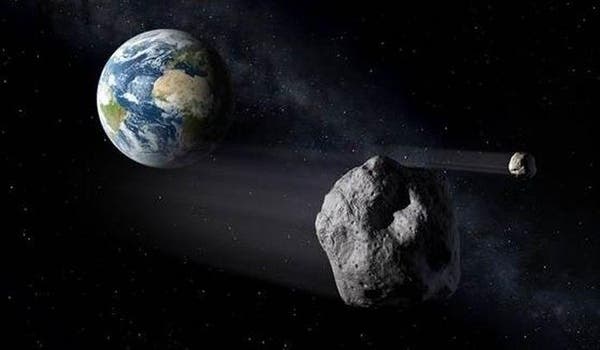
Asteroid Apophis was discovered in 2004 but NASA scientists have ruled out the possibility of it hitting Earth in 2036.

Earthlings can breathe a sigh of relief; NASA scientists have officially ruled out the possibility of the 22 million ton asteroid Apophis (1066 feet across) smashing into the planet in 2036. http://en.wikipedia.org/wiki/99942_Apophis
"The impact odds as they stand now are less than one in a million, which makes us comfortable saying we can effectively rule out an Earth impact in 2036," manager of NASA's Near-Earth Object Program Office Don Yeomans said in a statement. "Our interest in asteroid Apophis will essentially be for its scientific interest for the foreseeable future."
Apophis is still en route to come exceedingly close to Earth in 2029, however. According to NASA scientists, the asteroid will make history with the closest flyby of an asteroid its size when it grazes the planet's atmosphere at 19,400 miles above Earth's surface.
Initially, when discovered in 2004, scientists feared that Apophis would collide with the Earth in 2029. First calculations of the asteroid's orbit gave it a 2.7 percent chance of crashing into the planet. After new data discoveries in 2007, however, scientists ruled out the possibility of a 2029 collision scenario.
Still, the possibility of a 2036 impact remained. NASA scientists have been hard at work ever since trying to figure out the possibility of Apophis, which is the size of three-and-a-half football fields, hitting the Earth. Using information from both ground and space-based telescopes in 2011 and 2012, as well as data from the asteroid's distant flyby yesterday, they've finally concluded the planet is safe.
For those asteroid gazers, a lesser-known 131-foot asteroid called 2012 DA14 is expected to speed past the planet in the middle of February. This one could come as close as 17,200 miles above the Earth's surface.
"With new telescopes coming online, the upgrade of existing telescopes and the continued refinement of our orbital determination process, there's never a dull moment working on near-Earth objects," Yeomans said.
***
Apophis asteroid update: it definitely won’t hit Earth in 2036
Published on Fri, Jan 11, 2013 by Mihai Andrei
These past couple of days have been marked by the Apophis asteroid, one of the objects passing closest to our planet. While this year’s passing was far enough for comfort, Apophis was expected to make a more closer passing in 2036 – but revised calculations have now showed there is no need for panic.
After closely examining the asteroid as it buzzed past Earth, astrophysicists concluded thatApophis will not get closer than 31,000km as it flies past on this date.
“Radar data we have collected over the past couple of weeks have completely excluded any chance of impact in 2036. Furthermore, we can now precisely predict its trajectory decades into the future,” Marina Brozovic of the Nasa’s Jet Propulsion Laboratory told the BBC Stargazing Live programme.
Apophis was named after an Egyptian demo of destruction and darkness, and if it were to collide with Earth, the impact would be 9 times more powerful than any bomb detonated on Earth. You can read more about the asteroid here.
***
NM Tech helps trim asteroid collision odds
Updated: Saturday, 12 Jan 2013, 3:29 PM MST
Published : Saturday, 12 Jan 2013, 3:16 PM MST
Published : Saturday, 12 Jan 2013, 3:16 PM MST
SOCORRO, N.M. (KRQE) - Attention planet Earth: a big threat to life as we know it is now predicted to sail past our planet in 23 years.
The so-called doomsday asteroid is no longer believed to be on a collision course with Earth.
And we know that now thanks in large part to researchers in New Mexico.
The discovery of the 1,000-foot-wide asteroid "Apophis" in 2004 led to disturbing calculations and a fear the flying rock would smash into earth.
The numbers gave it about a 3 percent chance it would happen, the highest risk astronomers have ever predicted.
"The Earth would go around the sun seven times, the asteroid would go around the Earth six times, and they would meet up at the same place at the same time--April 13th, 2036," Donald Yeomans of NASA said last year. "It will be important to look at this asteroid in 2013."
And in 2013 a giant telescope above Socorro did take another look at the space rock.
"We collected data with our telescope on Magdalena Ridge , and Jet Propulsion Laboratory at NASA does the orbit calculations." said Dr. Eileen Ryan of New Mexico Tech.
That data collected in New Mexico helped come up with new numbers replacing the earlier collision chance of 3 in 100.
"That possibility has dropped to one in a million that this object will hit in 2036, so we can breathe a sigh of relief," Ryan said.
New Mexico Tech played a key role in finding out that the doomsday asteroid is no longer a threat.
"There a many people who took observations of Apophis, but there are certain critical times to take the data that make a big difference on how accurately we can predict the orbit," Ryan continued. "So NM Tech and also the Panstar telescope in Hawaii provided the most critical databases."
"There a many people who took observations of Apophis, but there are certain critical times to take the data that make a big difference on how accurately we can predict the orbit," Ryan continued. "So NM Tech and also the Panstar telescope in Hawaii provided the most critical databases."
But Ryan says their work is never done. They discover 20 new objects a night.
"And as long as we're not in the same place at the same time, everything great," Ryan said.
"And as long as we're not in the same place at the same time, everything great," Ryan said.
NASA says the asteroid won't get closer than 19,400 miles to Earth.
The rock could have done significant damage, but it wouldn't have meant the end of the world.

No comments:
Post a Comment